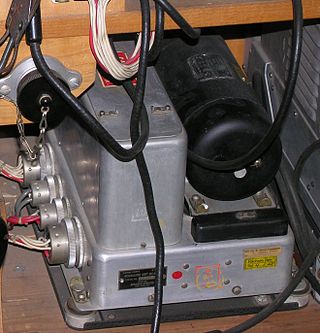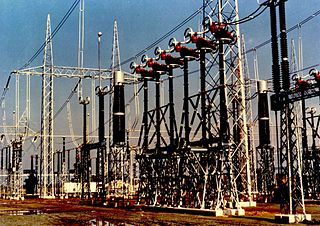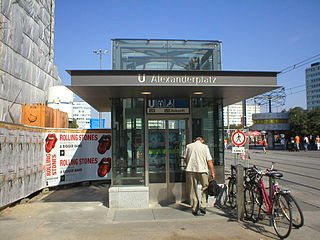In electrical engineering, a switch is an electrical component that can disconnect or connect the conducting path in an electrical circuit, interrupting the electric current or diverting it from one conductor to another. The most common type of switch is an electromechanical device consisting of one or more sets of movable electrical contacts connected to external circuits. When a pair of contacts is touching current can pass between them, while when the contacts are separated no current can flow.
In engineering, a fail-safe is a design feature or practice that, in the event of a specific type of failure, inherently responds in a way that will cause minimal or no harm to other equipment, to the environment or to people. Unlike inherent safety to a particular hazard, a system being "fail-safe" does not mean that failure is impossible or improbable, but rather that the system's design prevents or mitigates unsafe consequences of the system's failure. That is, if and when a "fail-safe" system fails, it remains at least as safe as it was before the failure. Since many types of failure are possible, failure mode and effects analysis is used to examine failure situations and recommend safety design and procedures.

A dead man's switch is a switch that is designed to be activated or deactivated if the human operator becomes incapacitated, such as through death, loss of consciousness, or being bodily removed from control. Originally applied to switches on a vehicle or machine, it has since come to be used to describe other intangible uses, as in computer software.

A kill switch, also known more formally as an emergency brake, emergency stop (E-stop), emergency off (EMO), or emergency power off (EPO), is a safety mechanism used to shut off machinery in an emergency, when it cannot be shut down in the usual manner. Unlike a normal shut-down switch or shut-down procedure, which shuts down all systems in order and turns off the machine without damage, a kill switch is designed and configured to abort the operation as quickly as possible and to be operated simply and quickly. Kill switches are usually designed to be noticeable, even to an untrained operator or a bystander.

A motor–generator is a device for converting electrical power to another form. Motor–generator sets are used to convert frequency, voltage, or phase of power. They may also be used to isolate electrical loads from the electrical power supply line. Large motor–generators were widely used to convert industrial amounts of power while smaller motor–generators were used to convert battery power to higher DC voltages.

In railway signalling, an interlocking is an arrangement of signal apparatus that prevents conflicting movements through an arrangement of tracks such as junctions or crossings. In North America, a set of signalling appliances and tracks interlocked together are sometimes collectively referred to as an interlocking plant or just as an interlocking. An interlocking system is designed so that it is impossible to display a signal to proceed unless the route to be used is proven safe.
Backfeeding is the flow of electric power in the direction reverse to that of the generally understood or typical flow of power. Depending on the source of the power, this reverse flow may be intentional or unintentional. If not prevented or properly performed, backfeeding may present unanticipated hazards to electrical grid equipment and service personnel.

In an electric power system, a switchgear is composed of electrical disconnect switches, fuses or circuit breakers used to control, protect and isolate electrical equipment. Switchgear is used both to de-energize equipment to allow work to be done and to clear faults downstream. This type of equipment is directly linked to the reliability of the electricity supply.

In electrical engineering, a disconnector, disconnect switch or isolator switch is used to ensure that an electrical circuit is completely de-energized for service or maintenance. They are often found in electrical distribution and industrial applications, where machinery must have its source of driving power removed for adjustment or repair. Disconnectors can be operated manually or by a motor, and may be paired with an earthing switch to ground the portion that has been isolated from the system for ensuring the safety of equipment and the personnel working on it.

Lock out, tag out (LOTO) is a safety procedure used to ensure that dangerous equipment is properly shut off and not able to be started up again prior to the completion of maintenance or repair work. It requires that hazardous energy sources be "isolated and rendered inoperative" before work is started on the equipment in question. The isolated power sources are then locked and a tag is placed on the lock identifying the worker and reason the LOTO is placed on it. The worker then holds the key for the lock, ensuring that only they can remove the lock and start the equipment. This prevents accidental startup of equipment while it is in a hazardous state or while a worker is in direct contact with it.

A transfer switch is an electrical switch that switches a load between two sources. Some transfer switches are manual, in that an operator effects the transfer by throwing a switch, while others are automatic and trigger when they sense one of the sources has lost or gained power.

In electrical engineering, a limit switch is a switch operated by the motion of a machine part or the presence of an object. A limit switch can be used for controlling machinery as part of a control system, as a safety interlock, or as a counter enumerating objects passing a point.

An arc flash is the light and heat produced as part of an arc fault, a type of electrical explosion or discharge that results from a connection through air to ground or another voltage phase in an electrical system.

A pressure switch is a form of switch that operates an electrical contact when a certain set fluid pressure has been reached on its input. The switch may be designed to make contact either on pressure rise or on pressure fall. Pressure switches are widely used in industry to automatically supervise and control systems that use pressurized fluids.

Vandal-resistant switches are electrical switches designed to be installed in a location and application where they may be subject to abuse and attempts to damage them, as in the case of pedestrian crossing switches. Vandal-resistant switches located on devices that are outdoors must be able to withstand extreme temperatures, dust, rain, snow, and ice. Many vandal-resistant switches are intended to be operated by the general public, and must withstand heavy use and even abuse, such as attempts to damage the switch with metal tools. These switches must also resist dirt and moisture.

An elevator or lift is a machine that vertically transports people or freight between levels. They are typically powered by electric motors that drive traction cables and counterweight systems such as a hoist, although some pump hydraulic fluid to raise a cylindrical piston like a jack.

Trapped-key interlocking utilizes locks and keys for sequential control of equipment and machinery to ensure safe operation. Trapped-key interlocks are widely used to ensure safe access to potentially live or dangerous plant or equipment in an industrial setting.
Machine guarding is a safety feature on or around manufacturing or other engineering equipment consisting of a shield or device covering hazardous areas of a machine to prevent contact with body parts or to control hazards like chips or sparks from exiting the machine. Machine guarding provides a means to protect humans from injury while working nearby or while operating equipment. It is often the first line of defense to protect operators from injury while working on or around industrial machinery during normal operations. In the U.S., machine guarding is referred to in OSHA's CFR 1910.212; in the U.K., machinery safety is covered mainly by PUWER."
A high-resistance connection (HRC) is a hazard that results from loose or poor connections in traditional electrical accessories and switchgear which can cause heat to develop, capable of starting a fire.

Workplace robotics safety is an aspect of occupational safety and health when robots are used in the workplace. This includes traditional industrial robots as well as emerging technologies such as drone aircraft and wearable robotic exoskeletons. Types of accidents include collisions, crushing, and injuries from mechanical parts. Hazard controls include physical barriers, good work practices, and proper maintenance.



















